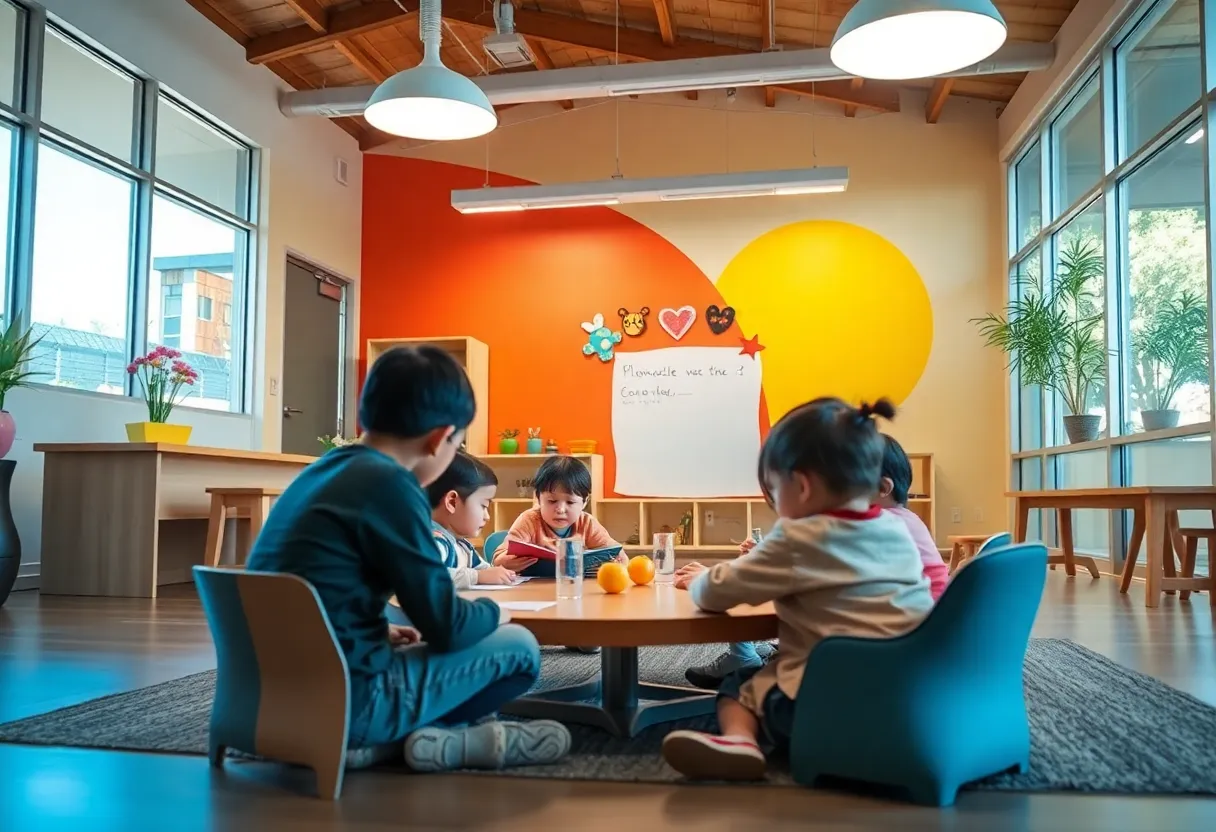Albuquerque, October 27, 2025
Sandia Pueblo has opened a state-of-the-art early childhood development center in Albuquerque, focusing on bilingual education and cultural preservation. The $8 million facility is designed to support up to 150 children from infancy to age five, with an emphasis on holistic growth and community engagement. Funded through tribal and federal resources, the center aims to empower Native American families by enhancing educational access and fostering intergenerational connections.
Sandia Pueblo Opens State-of-the-Art Early Childhood Development Center in Albuquerque
Albuquerque – Sandia Pueblo has launched a new early childhood development center designed to support young children through bilingual education and cultural preservation efforts. This $8 million facility will accommodate up to 150 children from infancy to age five, marking a significant investment in the community’s future. Funded through tribal resources and federal grants, the center aims to empower youth while strengthening family and community bonds.
The center’s opening highlights a commitment to inclusive education for Native American families in the region. Local partnerships with universities will incorporate STEM programs, preparing children for leadership roles in a modern world. City officials have acknowledged the initiative’s role in fostering broader community growth and educational equity.
Facility Features and Educational Focus
The center provides a nurturing environment tailored to the developmental needs of very young children. Spaces are equipped for age-appropriate activities, including play-based learning that integrates bilingual education in English and Native languages. This approach helps preserve cultural heritage while building essential language skills from an early age.
Daily programs emphasize holistic growth, covering physical, emotional, and cognitive milestones. Staff trained in early childhood education will guide activities that promote social interaction and cultural awareness. The facility includes modern amenities such as safe outdoor play areas and indoor classrooms designed for small group settings, ensuring personalized attention for each child.
Funding and Community Impact
Construction of the center was made possible by a combination of tribal funding and federal grant support, totaling $8 million. This financial backing reflects ongoing efforts to address gaps in early education access for tribal communities. The project creates immediate jobs in education and administration, while long-term benefits include improved school readiness for participants.
By serving 150 children, the center addresses a critical need in Albuquerque’s Native American population. Families gain reliable childcare options, allowing parents to pursue work or education without concern for their children’s well-being. The initiative also promotes intergenerational connections by involving elders in cultural programming, reinforcing traditional values alongside contemporary learning.
Partnerships and Future Programs
Collaborations with nearby universities bring specialized resources to the center, particularly in STEM education. These partnerships will introduce hands-on activities like basic science experiments and math games adapted for preschoolers. The goal is to spark curiosity and build foundational skills that can lead to higher education and career success.
Future expansions may include extended hours or additional services, based on community feedback. The center’s design allows for scalability, ensuring it can adapt to growing enrollment. This forward-thinking model sets a precedent for other tribal nations seeking to invest in early childhood infrastructure.
Broader Context of Native American Education Initiatives
In recent years, tribal communities across the Southwest have prioritized early education to combat historical disparities. Programs like this one build on federal policies aimed at supporting Indigenous languages and cultures. The Sandia Pueblo center stands out for its integration of tradition and innovation, serving as a model for sustainable development.
Local leaders view the opening as a step toward greater inclusivity in Albuquerque’s educational landscape. By focusing on underserved populations, the facility contributes to economic stability and social cohesion. As the center begins operations, it will play a key role in nurturing the next generation of community stewards.
The launch event drew attendance from various stakeholders, underscoring the project’s importance. Ongoing evaluations will track outcomes such as language proficiency and developmental progress, informing future improvements. This investment not only benefits immediate families but also lays groundwork for long-term community resilience.
Challenges and Opportunities Ahead
While the center represents progress, challenges like staffing shortages in specialized education persist. Tribal efforts to recruit and retain qualified educators will be crucial. Opportunities abound, however, through continued grant funding and policy support at the state level.
Overall, the Sandia Pueblo early childhood development center exemplifies proactive planning in Native American education. Its emphasis on bilingualism, culture, and STEM positions children for success in diverse fields. As it serves its first cohort, the facility promises to enrich Albuquerque’s cultural and educational fabric.
Frequently Asked Questions (FAQ)
What is the purpose of the new early childhood development center opened by Sandia Pueblo?
The center focuses on bilingual education and cultural preservation to support young children in the community.
How many children can the facility accommodate?
The facility will serve 150 children from infancy to age five.
What is the cost of the center and how was it funded?
The center cost $8 million, funded by tribal resources and federal grants.
What kind of programs will the center offer?
Programs will include bilingual education, cultural preservation activities, and STEM integration through university partnerships.
Where is the center located?
The center is located in Albuquerque.
Key Features of the Sandia Pueblo Early Childhood Development Center
| Feature | Description |
|---|---|
| Capacity | 150 children from infancy to age five |
| Funding | $8 million from tribal and federal grants |
| Educational Focus | Bilingual education and cultural preservation |
| Partnerships | Local universities for STEM programs |
| Location | Albuquerque |
Deeper Dive: News & Info About This Topic
HERE Resources
Albuquerque Public Schools Seeks Community Feedback on Budget
APS Seeks Community Input on Upcoming Budget
Albuquerque Educator Joyce Godwin Recognized for STEM Innovations
Albuquerque Man Receives Five-Year Sentence for School Bus Crash
New Mexico Early Childhood Providers Offer Mixed Feedback on Child Care Plan
New Fitness Center for Kids Opens in Albuquerque





